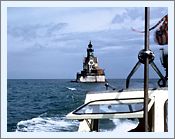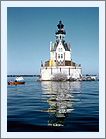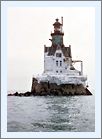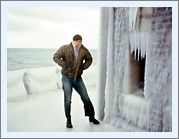|
Historical
Information

Stretching two and a half miles in length and a scant half-mile
off the harbor entrance, Racine Reef lurked less than ten feet below the
surface at its shallowest point, and had claimed many a vessel making
its way in and out of Racine harbor over the years. While the Root River
Light had been guiding mariners into the mouth of the Root River for
almost thirty years, it was not until 1868 that the Lighthouse Board
undertook an evaluation of marking the hazard of the reef itself.
 Simultaneous to this evaluation, the
Board was considering the construction of a major 108-foot tall coast
light at Wind Point, some three and a half miles to the north. With the
cost of constructing a manned station on the reef itself identified as
being prohibitive, the Board determined that the combination of an
auxiliary Sixth Order Fresnel
lens atop this new tower with its beam directed
towards the reef and a buoy upon the reef itself would provide the most
cost-effective solution to marking the hazard. To this end a buoy was
placed on Racine Reef in 1869 and the Board followed-up with a request
for $40,000 for the construction of the light at Wind Point in its
annual report for fiscal 1870. Congress was slow to act upon the
request, and the light at Wind Point was not completed and exhibited
until November 15, 1880. Simultaneous to this evaluation, the
Board was considering the construction of a major 108-foot tall coast
light at Wind Point, some three and a half miles to the north. With the
cost of constructing a manned station on the reef itself identified as
being prohibitive, the Board determined that the combination of an
auxiliary Sixth Order Fresnel
lens atop this new tower with its beam directed
towards the reef and a buoy upon the reef itself would provide the most
cost-effective solution to marking the hazard. To this end a buoy was
placed on Racine Reef in 1869 and the Board followed-up with a request
for $40,000 for the construction of the light at Wind Point in its
annual report for fiscal 1870. Congress was slow to act upon the
request, and the light at Wind Point was not completed and exhibited
until November 15, 1880.
Eventually realizing that the auxiliary
red Sixth Order lens was not sufficiently visible at sea to adequately
serve as an effective warning for Racine Reef, the lens was replaced by
a more powerful locomotive headlight with a parabolic reflector in 1897.
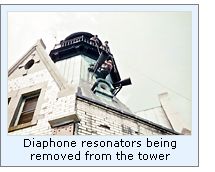 As the nineteenth century drew to a
close, the Lighthouse Board came to the realization that the Wind Point
solution was not serving as an adequate warning for the reef, and the
Board set upon the task of planning a more permanent aid to navigation
directly atop the reef itself. However, still deeming the cost of
constructing a manned station as being prohibitive, plans were instead
drawn-up for the construction of a concrete crib topped by a small tower
with a Pintsch gas powered light, to be serviced by the keepers of the
Harbor Lights by boat. As the nineteenth century drew to a
close, the Lighthouse Board came to the realization that the Wind Point
solution was not serving as an adequate warning for the reef, and the
Board set upon the task of planning a more permanent aid to navigation
directly atop the reef itself. However, still deeming the cost of
constructing a manned station as being prohibitive, plans were instead
drawn-up for the construction of a concrete crib topped by a small tower
with a Pintsch gas powered light, to be serviced by the keepers of the
Harbor Lights by boat.
To this end, a wooden crib, forty feet
square and nine feet high was constructed onshore in the harbor and
towed out to the reef in August 1898, and sunk on the bottom by filling
with bags of concrete. The crib was then faced with paving brick, and
the structure topped with a level cap of concrete. Between October and
November, sixty cords of riprap were then distributed around the
structure to break up wave action and help prevent erosion, and with the
arrival of ice and winter storms the work was halted until the opening
of navigation the following year. Over that winter, contracts were
awarded for the construction of a tower and the Pintsch gas illuminating
apparatus, and delivered at the Milwaukee depot. Work on the reef
resumed the following spring, and continued through the summer, and
after an initial charging of the storage tank with gas the new light was
exhibited for the first time on the night of August 31, 1899.
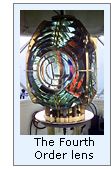 On the opening of the season of
navigation the following year, it was found that the action of the
winter ice had again caused significant damage to the exterior surfaces
of the crib, and as a temporary measure, two cords of old building stone
left over from the demolition of the upper section of the tower at
Rawley Point in 1894 were shipped to the reef and added to the riprap
protection installed the previous year. After the gas tanks ran empty on
a couple of occasions causing the light to be extinguished, one of the
gas storage tanks was replaced with a larger capacity unit, and in what
would become a virtually annual ritual on the reef, another eighty-one
cords of riprap were deposited around the crib by the end of 1900. On the opening of the season of
navigation the following year, it was found that the action of the
winter ice had again caused significant damage to the exterior surfaces
of the crib, and as a temporary measure, two cords of old building stone
left over from the demolition of the upper section of the tower at
Rawley Point in 1894 were shipped to the reef and added to the riprap
protection installed the previous year. After the gas tanks ran empty on
a couple of occasions causing the light to be extinguished, one of the
gas storage tanks was replaced with a larger capacity unit, and in what
would become a virtually annual ritual on the reef, another eighty-one
cords of riprap were deposited around the crib by the end of 1900.
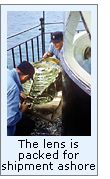 It soon became plain that the new light
was ill-suited for its purpose on a number of levels. Even under the
best conditions, the shallow and rocky water around the crib made it
extremely difficult for the lighthouse tender Dahlia to get any closer
than 900 feet from the crib, making filling of the gas storage tanks
extremely difficult, and with the shipping channels between Milwaukee
and Chicago frequently kept open all year, this job became virtually
impossible with the arrival of winter ice. Finally, the Pintsch gas
illumination itself proved to be extremely bothersome, and while the
contractors who installed the light were forced to return to make
adjustments to the light on a number of occasions, the quality of the light was never
considered satisfactory. In a last-ditch effort to increase the
visibility of the failing light, it was increased in height by the
addition of a twenty-foot tall skeletal iron structure atop the existing
tower in 1901 - along with the inevitable addition of twenty-five yards
of additional riprap around the base of the crib. It soon became plain that the new light
was ill-suited for its purpose on a number of levels. Even under the
best conditions, the shallow and rocky water around the crib made it
extremely difficult for the lighthouse tender Dahlia to get any closer
than 900 feet from the crib, making filling of the gas storage tanks
extremely difficult, and with the shipping channels between Milwaukee
and Chicago frequently kept open all year, this job became virtually
impossible with the arrival of winter ice. Finally, the Pintsch gas
illumination itself proved to be extremely bothersome, and while the
contractors who installed the light were forced to return to make
adjustments to the light on a number of occasions, the quality of the light was never
considered satisfactory. In a last-ditch effort to increase the
visibility of the failing light, it was increased in height by the
addition of a twenty-foot tall skeletal iron structure atop the existing
tower in 1901 - along with the inevitable addition of twenty-five yards
of additional riprap around the base of the crib.
In what was tantamount to an admission
of failure, the Lighthouse Board requested the sum of $75,000 for the
construction of a 60-foot tall, year-round manned light station and fog
signal on the reef in its annual report for 1902. After the Secretary of
the Treasury personally wrote a letter to Congress requesting the
funding, Congress approved the appropriation of $75,000 for the
construction of the new light on March 3, 18903. Under the direction of
Captain James G. Warren of the Corps of Engineers, the draftsmen at the
Ninth District depot in Milwaukee created the plans and specifications
for what could arguably be considered one of the grandest structures
undertaken by Lighthouse Board in its half century of responsibility for
the nation's aids to navigation.
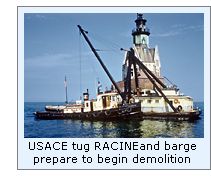 In November and December of 1904, the lighthouse tender
HYACINTH conducted a survey of an area in sixteen feet of water to the northeast of the existing
light for the new station. Over that winter, bids were advertised
for the construction of the new concrete crib, the structural steel framing and the iron and copper sheathing for the dwelling
and centrally
integrated tower. Work on the reef began the following year with the
tender DAHLIA towing the sixty-foot square timber crib out of
Racine harbor where it had been constructed, and placing it on the reef
which had been cleared to accept it. The crib was then sunk through the
addition of ballast stone into pockets within. Work then turned to the
casting of the concrete exterior of the pier and the basement engine
room, which was centrally formed within the concrete of the pier.
Finally, almost as an homage to the old light, seventy-six tons of
riprap were spread around the base of the crib. Work on the crib was
completed in October, 1905, and attention turned toward the construction
of the dwelling itself. In November and December of 1904, the lighthouse tender
HYACINTH conducted a survey of an area in sixteen feet of water to the northeast of the existing
light for the new station. Over that winter, bids were advertised
for the construction of the new concrete crib, the structural steel framing and the iron and copper sheathing for the dwelling
and centrally
integrated tower. Work on the reef began the following year with the
tender DAHLIA towing the sixty-foot square timber crib out of
Racine harbor where it had been constructed, and placing it on the reef
which had been cleared to accept it. The crib was then sunk through the
addition of ballast stone into pockets within. Work then turned to the
casting of the concrete exterior of the pier and the basement engine
room, which was centrally formed within the concrete of the pier.
Finally, almost as an homage to the old light, seventy-six tons of
riprap were spread around the base of the crib. Work on the crib was
completed in October, 1905, and attention turned toward the construction
of the dwelling itself.
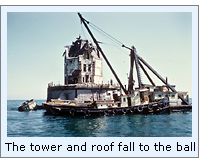 The "Victorianesque" main
station building was designed with an internal skeleton of structural
steel around which an exterior skin of brick, cruciform in plan, was
laid. With four main decks, the building stood sixty-six feet from the
upper surface of the crib on which it was constructed to the top of the
lantern. At the station's lowest level, the basement engine room was
provided with a high ceiling which extended into the first deck. Large
glass "French doors" on an exterior first floor wall both
allowed light into the basement and provided a large opening through
which equipment could be moved in and out of the engine room by way of a
hoist above the doors. Outfitted with coal-fired twin boilers which
provided steam for both the ten-inch fog whistles and the station's
central heating system. A large diameter steel chimney led from the
boilers through the three living areas above to exit on the gallery, and
extended above the roof of the lantern to help move smoke from the
boilers away from the station. The "Victorianesque" main
station building was designed with an internal skeleton of structural
steel around which an exterior skin of brick, cruciform in plan, was
laid. With four main decks, the building stood sixty-six feet from the
upper surface of the crib on which it was constructed to the top of the
lantern. At the station's lowest level, the basement engine room was
provided with a high ceiling which extended into the first deck. Large
glass "French doors" on an exterior first floor wall both
allowed light into the basement and provided a large opening through
which equipment could be moved in and out of the engine room by way of a
hoist above the doors. Outfitted with coal-fired twin boilers which
provided steam for both the ten-inch fog whistles and the station's
central heating system. A large diameter steel chimney led from the
boilers through the three living areas above to exit on the gallery, and
extended above the roof of the lantern to help move smoke from the
boilers away from the station.
The main entrance to the station was gained through a
narrow steel door on the first deck above which "1906" was carved into the limestone lintel. The
door opened onto a landing with two sets of stairs, one leading down to the
engine room floor, and one up to the second deck. With a central hall connecting a galley, day room and an office,
the second floor served as the primary living area for the station, and two bedrooms and a head rounded-out
the keeper's living area on the third deck. The stairs on the third deck
lead up to the watch room, which was centered within the roof, both of which
were clad with folded-seam seamed copper sheeting. The watch room featured
four small round portholes through which the keepers could keep an eye out
for vessels in trouble. Atop the watch room, an octagonal lantern with vertical astragals contained the station's
Fourth Order Fresnel lens, which
sat atop a four-posted solid brass pedestal. The lens rotated at a relatively
high speed providing a repetitive characteristic .07 second red flash followed by 4.3
seconds of white light.
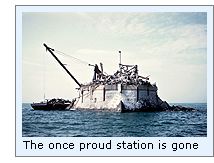 Two attached outbuildings on the crib completed the structure. One of which was used for coal storage for the boilers and the other a boathouse into which the boat was raised and swung using the steam-powered derrick on the crib. With the
exhibition of the light for the first time on a date which we have yet
been unable to determine, the old Pintsch light and tower were removed and shipped to
Chicago, where it was installed on the outer breakwater. No longer serving any purpose, the locomotive headlight on Wind Point was removed. Two attached outbuildings on the crib completed the structure. One of which was used for coal storage for the boilers and the other a boathouse into which the boat was raised and swung using the steam-powered derrick on the crib. With the
exhibition of the light for the first time on a date which we have yet
been unable to determine, the old Pintsch light and tower were removed and shipped to
Chicago, where it was installed on the outer breakwater. No longer serving any purpose, the locomotive headlight on Wind Point was removed.
The last listing for the Racine Reef
Light appeared in the Lighthouse Board annual report for 1908, stating
merely that all work on the station was complete, with the exception of
placing additional riprap for protection of the crib.
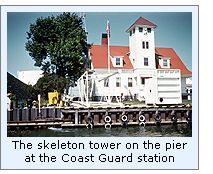 While
the station was located only a mile off the harbor, that mile proved to
be treacherous for keepers stationed at the station. While
the station was located only a mile off the harbor, that mile proved to
be treacherous for keepers stationed at the station.
At 7 am on Sunday March 1, 1908, Keeper
George Cornell left the station on a misty morning headed for shore.
Unable to see that the water between the station and shore was a field
of loosely broken ice, Cornell continued to push his way to shore. As
the wind shifted, ice began to blow towards the shore, and Cornell soon
found that he was locked fast in the ice. After an hour of sitting
hopelessly in his boat, someone on shore caught sight of the stranded
keeper and alerted a couple of fish tugs in the harbor who began
breaking a path through the ice towards Cornell. Three hours later, they
managed to break their way through to keeper Cornell, and returned him
to the station. Evidently, they arrived just in time, as the wind had
shifted, and the mass ice in which he found himself entrapped was being
pushed out to sea.
Ten years later on September 4, 1918,
William Larson who had served at the Racine Breakwater Light and was
visiting the keepers at Racine Reef was less fortunate than Cornell.
Falling from his boat on his way back to the harbor, Larson drowned when
he found himself unable to climb back into his row boat as a result of
high winds. While a search for Larson was immediately conducted, no sign
of his body could be found. A month later, Larson's body was discovered
on the beach at New Buffalo on October 9, over 100 miles to the
southeast of Racine.
At some time between 1924 and 1928 the
station's 10-inch steam powered fog whistles were replaced with
duplicate air-powered diaphone fog signals, and the sound characteristic
modified to a repetitive cycle of a 3-second blast followed by
27-seconds of silence. However, since the station was heated by steam,
and the boilers continued to be necessary, the old 10-inch fog whistles
were left in the building to serve as a backup system to the diaphones.
The station was electrified after the
Coast Guard assumed responsibility for the nation's aids to navigation
in 1939, and with advances in Radar and radio navigation in the early 1960's combined with
rapidly escalating maintenance costs, the Coast Guard made the difficult
decision to demolish the majestic building in 1961. To prepare for
demolition, the three-man crew assigned to the Reef were charged with
removing everything of value, including the motors, compressors,
diaphones, Fresnel lens and all of the station's furnishings.
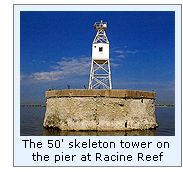 The demolition itself was undertaken by
the United States Army Corps of Engineers based out of Kewaunee. In an
ironic twist of fate, the demolition was undertaken by the sixty-six
foot tug Racine, which had been built by the Marine Iron and
Shipbuilding Company of Duluth in 1955. With the arrival of the Racine
with a wrecking barge in tow, the old station quickly fell to the
wrecking ball over a two month period in the summer of 1961. While the
wrecking work was underway, the sections of a prefabricated skeletal
tower to be assembled on the crib was delivered at the Racine Coast
Guard station. The demolition itself was undertaken by
the United States Army Corps of Engineers based out of Kewaunee. In an
ironic twist of fate, the demolition was undertaken by the sixty-six
foot tug Racine, which had been built by the Marine Iron and
Shipbuilding Company of Duluth in 1955. With the arrival of the Racine
with a wrecking barge in tow, the old station quickly fell to the
wrecking ball over a two month period in the summer of 1961. While the
wrecking work was underway, the sections of a prefabricated skeletal
tower to be assembled on the crib was delivered at the Racine Coast
Guard station.
With the final remnants of the once
majestic station stripped from the crib, the new white skeletal tower
was loaded on the barge, towed out to the reef and erected on the naked
crib, where it stands to this day, its white acrylic lens flashing every
six seconds from fifty feet above the water, warning mariners of the
dangerous rocks (and uncounted tons of riprap) that still lurk beneath
the surface.

Keepers of this Light

Click Here
to see a complete listing of
all Racine Reef Light keepers compiled by Phyllis L. Tag of Great Lakes
Lighthouse Research.

Finding this Light

From
I-94, take Hwy 20 east. Hwy 20 eventually becomes Washington Ave. Follow
Washington Ave. to Hwy 32, and head north on Hwy 32. Turn right on
Christopher Columbus Causeway, and follow around the marina until the
road ends in a parking area. Walk the short distance to the lighthouse
at the marina entrance.

Reference Sources

Annual reports of the Lighthouse Board, 1868 through 1909.
Great Lakes Light Lists, various, 1924 through 1953.
Great Lakes Coast Pilots, various, 1952 - 2000
Photographs of Racine Reef in 1961 courtesy of Jerry Schober.
Photograph of existing light courtesy Ken & Barb Wardius, 2001.
Email interviews with Jerry Schober, October & November 2001.
The Door Count Advocate, various issues, 1906 - 1918
Keeper listings for this light appear
courtesy of Great
Lakes Lighthouse Research
|
